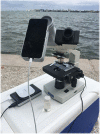HABscope: A tool for use by citizen scientists to facilitate early warning of respiratory irritation caused by toxic blooms of Karenia brevis
- PMID: 31220134
- PMCID: PMC6586399
- DOI: 10.1371/journal.pone.0218489
HABscope: A tool for use by citizen scientists to facilitate early warning of respiratory irritation caused by toxic blooms of Karenia brevis
Abstract
Blooms of the toxic microalga Karenia brevis occur seasonally in Florida, Texas and other portions of the Gulf of Mexico. Brevetoxins produced during Karenia blooms can cause neurotoxic shellfish poisoning in humans, massive fish kills, and the death of marine mammals and birds. Brevetoxin-containing aerosols are an additional problem, having a severe impact on beachgoers, triggering coughing, eye and throat irritation in healthy individuals, and more serious respiratory distress in those with asthma or other breathing disorders. The blooms and associated aerosol impacts are patchy in nature, often affecting one beach but having no impact on an adjacent beach. To provide timely information to visitors about which beaches are low-risk, we developed HABscope; a low cost (~$400) microscope system that can be used in the field by citizen scientists with cell phones to enumerate K. brevis cell concentrations in the water along each beach. The HABscope system operates by capturing short videos of collected water samples and uploading them to a central server for rapid enumeration of K. brevis cells using calibrated recognition software. The HABscope has a detection threshold of about 100,000 cells, which is the point when respiratory risk becomes evident. Higher concentrations are reliably estimated up to 10 million cells L-1. When deployed by volunteer citizen scientists, the HABscope consistently distinguished low, medium, and high concentrations of cells in the water. The volunteers were able to collect data on most days during a severe bloom. This indicates that the HABscope can provide an effective capability to significantly increase the sampling coverage during Karenia brevis blooms.
Conflict of interest statement
The authors have declared that no competing interests exist.
Figures





Similar articles
-
Initial evaluation of the effects of aerosolized Florida red tide toxins (brevetoxins) in persons with asthma.Environ Health Perspect. 2005 May;113(5):650-7. doi: 10.1289/ehp.7500. Environ Health Perspect. 2005. PMID: 15866779 Free PMC article.
-
Illness associated with red tide--Nassau County, Florida, 2007.MMWR Morb Mortal Wkly Rep. 2008 Jul 4;57(26):717-20. MMWR Morb Mortal Wkly Rep. 2008. PMID: 18600196
-
Quantifying Karenia brevis bloom severity and respiratory irritation impact along the shoreline of Southwest Florida.PLoS One. 2022 Jan 5;17(1):e0260755. doi: 10.1371/journal.pone.0260755. eCollection 2022. PLoS One. 2022. PMID: 34986155 Free PMC article.
-
Neurotoxic shellfish poisoning.Mar Drugs. 2008;6(3):431-55. doi: 10.3390/md20080021. Epub 2008 Jul 12. Mar Drugs. 2008. PMID: 19005578 Free PMC article. Review.
-
Red Tide: Overview and Clinical Manifestations.J Allergy Clin Immunol Pract. 2020 Apr;8(4):1219-1223. doi: 10.1016/j.jaip.2019.10.030. Epub 2019 Nov 21. J Allergy Clin Immunol Pract. 2020. PMID: 31761688 Review.
Cited by
-
Imaging Technologies Build Capacity and Accessibility in Phytoplankton Species Identification Expertise for Research and Monitoring: Lessons Learned During the COVID-19 Pandemic.Front Microbiol. 2022 Apr 14;13:823109. doi: 10.3389/fmicb.2022.823109. eCollection 2022. Front Microbiol. 2022. PMID: 35495707 Free PMC article.
-
Usability and acceptance of crowd-based early warning of harmful algal blooms.PeerJ. 2023 Mar 1;11:e14923. doi: 10.7717/peerj.14923. eCollection 2023. PeerJ. 2023. PMID: 36879908 Free PMC article.
-
Airborne Cyanobacterial Toxins and Their Links to Neurodegenerative Diseases.Molecules. 2025 May 26;30(11):2320. doi: 10.3390/molecules30112320. Molecules. 2025. PMID: 40509208 Free PMC article. Review.
-
Revisiting harmful algal blooms in India through a global lens: An integrated framework for enhanced research and monitoring.iScience. 2025 Jan 28;28(2):111916. doi: 10.1016/j.isci.2025.111916. eCollection 2025 Feb 21. iScience. 2025. PMID: 40028282 Free PMC article. Review.
-
Introducing ARTiMiS: A Low-Cost Flow Imaging Microscope for Microalgal Monitoring.Environ Sci Technol. 2024 Jul 19;58(30):13540-51. doi: 10.1021/acs.est.4c01928. Online ahead of print. Environ Sci Technol. 2024. PMID: 39028920 Free PMC article.
References
-
- Poli M, Mende TJ, Baden DG. Brevetoxins, unique activators of voltage-sensitive sodium channels, bind to specific sites in rat brain synaptosomes. Mol Pharmacol. 1986;30(2):129–35. - PubMed
-
- Backer LC, Fleming LE, Rowan A, Cheng Y-S, Benson J, Pierce RH, et al. Recreational exposure to aerosolized brevetoxins during Florida red tide events. Harmful Algae. 2003;2(1):19–28.
-
- Baden DG, Mende TJ, Bikhazi G, Leung I. Bronchoconstriction caused by Florida red tide toxins. Toxicon. 1982;20(5):929–32. - PubMed
-
- Asai S, Krzanowski JJ, Anderson WH, Martin DF, Poison JB, Lockey RF, et al. Effects of the toxin of red tide, Ptychodiscus brevis, on canine tracheal smooth muscle: a possible new asthma-triggering mechanism. J Allergy Clin Immun. 1982;69(5):418–28. - PubMed
-
- Asai S, Krzanowski JJ, Lockey RF, Anderson WH, Martin DF, Polson JB, et al. The site of action of Ptychodiscus brevis toxin within the parasympathetic axonal sodium channel h gate in airway smooth muscle. J Allergy Clin Immun. 1984;73(6):824–8. - PubMed

